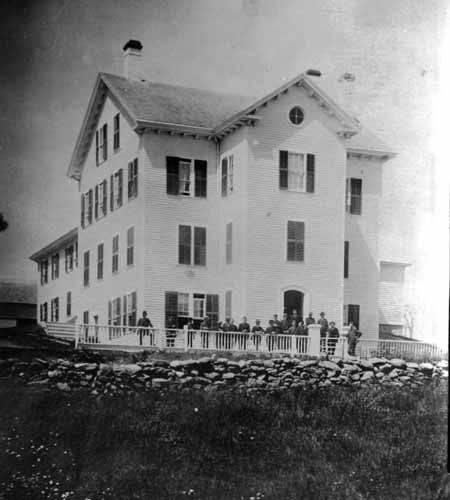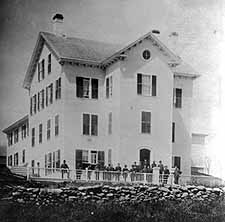|
This is an archived article.
For the latest news, go to the Advance
Homepage
For more archives, go to the Advance Archive/Search Page. |
||
|
The laboratory wasn't quite ready - but everything else to open an agricultural school for boys was in place. A public ceremony was postponed a week, but the doors of the Storrs Agricultural School opened for its first 12 or 13 students (records vary) on September 28, 1881. The story of the founding is well known - the gift of 170 acres of land with farm buildings and an old orphanage, plus a cash donation to pay for equipment and the draining of swampland. The property came from Augustus Storrs and the dollars from his brother, Charles. The main building of the new agricultural school had been an orphanage, which had been started by Edwin Whitney, who died shortly after it opened in 1866. The Connecticut Soldiers' Orphans Home closed 10 years later after the last resident came of age and moved away. The property reverted from the state to Whitney's widow, Minerva, who sold it to Augustus Storrs in 1878. Building 'Neat and
Sweet'
"The house is large and admirably arranged for a boarding school. In the basement is a school room fitted with desk and black board. The laundry and furnace are also in the basement. On the first floor are parlors, family sitting room, kitchen, large dining room, and lavatory. The second floor has two or three large chambers, and some dozen or more small bedrooms, beside an attic in the ell; and there are further sleeping accommodations on the next floor above. "The house is in good condition, tight, neat and sweet, well arranged and pleasantly located. Its outlook is to the northeast (it faced across what is now Route 195 toward Horsebarn Hill) and a row of splendid large maples extends along the roadside for 30 or 40 rods. There are good barns and sheds close at hand, beside a small house close by for a practical farmer who is now managing the farm temporarily." The article also described what state taxpayers could expect of the new school: "Instead of filling the young men up with theoretical book learning, and a great quantity of science which may not be immediately available, at a cost beyond the means of most parents, it is proposed to have a school, at which the cost of tuition will be merely nominal ($25 a year) and the price of board very low (not over $2.50 or $3 a week for 36 weeks.) Ample chance will be given for the boys to do extra work to pay, so that industrious and earnest students can earn enough for their expenses as they go. This is a very important consideration." Trustees would hire a principal to manage the school and farm work, and serve as general administrator. He would also serve as "head of the household", for this was to be a family, and the principal's wife "would be matron of the establishment, and exercise a home care over the boys." By the time the school opened five weeks later, Solomon Mead was principal, with Henry P. Armsby, a graduate of Yale's Sheffield Scientific School, as assistant principal and instructor. All preparations for the school opening were slowed, however, when on September 19 President James A. Garfield died. Shot by an assassin 11 weeks earlier, Garfield had been in office barely six months. On September 28, the Chronicle reported that most of the facilities were ready, but an open house would have to be postponed: "The living rooms and most of the rest of the building are in readiness, and all the arrangements for teaching have been perfected. But the laboratory is not fully furnished, and some other matters are not quite as forward as had been hoped. Although the applicants for tuition will be received on Wednesday, and practical operations will begin immediately, the public opening is deferred until next week Friday, October 7." The public opening included a ceremony at the Storrs Community Church, and "the church at Mansfield was filled with townspeople, a delegation from the Willimantic Farmers' Club, and citizens from various parts of the state," said Walter Stemmons, college editor, in his book Connecticut Agricultural College: A History, which chronicles the first 50 years of UConn. Daily: Prayers, Carpentry, Labor The curriculum, too, was rigorous. The students learned how to improve soil "by tillage, draining, manuring, irrigation," and the "culture and handling of the various field, garden and orchard crops of New England - grass, grain, roots, vegetables and fruits - from planting to market. The use, care and repair of farming tools, implements and machines. The breeding, rearing, training, feeding and use of live stock - cattle, horses, sheep, swine and poultry, including the best methods of dairy practice," said the school prospectus. There was also the business side to farming: "keeping accounts, inventory, capital, labor, rotation of crops, systems of farming adapted to various circumstances." Agricultural science "will comprise those sections of physical and natural science that have a directly useful bearing upon New England farming, viz.: agricultural chemistry; agricultural physics - the relations of air, water and soil to heat, rain, dew, frost, storm; agricultural mechanics - laws of motion and friction; principles of the construction of farm tools and machines; agricultural botany and zoology - classification of animals, special history of the agriculturally important quadrupeds, birds, fish, insects, useful and injurious; anatomy and physiology of the ox, horse, etc., common diseases of cattle etc., and their domestic treatment. There were also classes in reading, speaking, and writing on agricultural topics, as well as arithmetic and elementary geometry "as are serviceable upon the farm; surveying, and measuration of surfaces and solids." And they were taught "such simple carpenter and smith work as are useful in New England rural life." All of that was in addition to the manual labor. At the end of the first trimester, an unnamed Chronicle "correspondent" made a visit to the fledgling school, and his report was published on Dec. 14, 1881, as the first semester came to a close: "To day (sic) I visited the state agricultural school at Mansfield and had the privilege of dining with the family. It is a pleasant household in a commodious and sightly location. The principal, Solomon Meade, sits decorously at the head, as pater familias, cheerily, yet orderly and bountifully dealing out the viands. The table is also graced by Professor Armsby and wife and Professor (Benjamin Koons) Coons (sic); while the dozen of young men in attendance upon the school will fill up the flanks of the stout table, in the cheerful dining room. "The young men put in an appearance, with looks and conduct that declared contentment with their lot. Two of them undertook to interview the writer and volunteered the remarks that 'we have a first rate board here' and 'good times.' One young man told me that he had gained 14 pounds in weight since coming there. " In the afternoon is the time for farm work. Some were, soon after dinner, driving oxen and carts about; others were off for the woods or the log pile, with keen axes on shoulders, ready to make the chips fly. I noticed also text books on biology, on chemistry and physics and these accompanied by lectures and experiments, in class room and laboratory, are taught in an eminently practical way. "In my several visits there I may say that the impression received is that Mr. Storrs did well in conceiving the plan and in giving the farm; and the state does well in accepting and occupying it; and that lads intent on farm life can hardly do better than making use of the drill here afforded."  |

